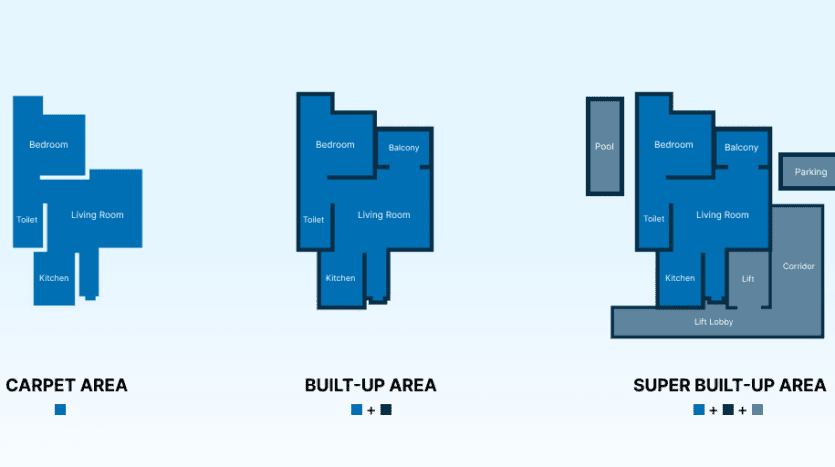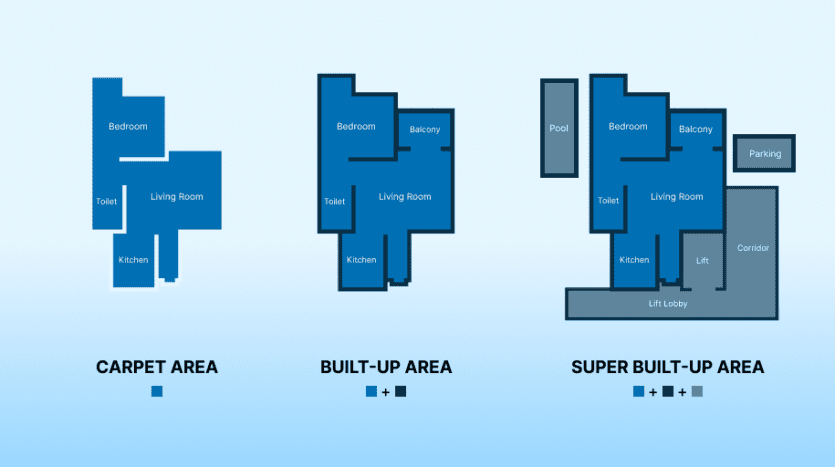Carpet Area vs Built-Up Area vs Super Built-Up Area vs Undivided Share of land : Know the differences
When it comes to buying a property, there are several terms that you need to be familiar with in order to make an informed decision. In this article, we will discuss four important terms: carpet area, built-up area, super built-up area, and undivided land share.
Carpet Area
Carpet area refers to the actual usable area of an apartment or property. It is the area that can be covered with a carpet or the area that is available for the occupant to use. Carpet area includes the area within the walls of the property, and does not include any common areas or spaces such as lobbies, staircases, elevators, or other similar spaces. Carpet area is measured from the inner walls of the property, and is typically the smallest of the three area measurements. Carpet area is important because it is the actual area available for use and is the basis for calculating the cost of the property.
Let’s consider an example to understand how carpet area is calculated:
Suppose you are looking to buy an apartment that has a total area of 1,000 square feet. The apartment has two bedrooms, a living room, a kitchen, and two bathrooms. To calculate the carpet area, you need to measure the usable area of each room.
Let’s assume that the dimensions of the rooms are as follows:
Bedroom 1: 12 feet x 10 feet
Bedroom 2: 10 feet x 10 feet
Living room: 18 feet x 15 feet
Kitchen: 10 feet x 8 feet
Bathroom 1: 6 feet x 5 feet
Bathroom 2: 6 feet x 4 feet
To calculate the carpet area, we need to add up the usable area of each room. Since carpet area includes only the usable area within the inner walls, we need to subtract the area occupied by the walls. Let’s assume that the wall thickness is 6 inches (0.5 feet).
Bedroom 1: (12 – 0.5) x (10 – 0.5) = 113.25 square feet
Bedroom 2: (10 – 0.5) x (10 – 0.5) = 94.5 square feet
Living room: (18 – 0.5) x (15 – 0.5) = 262.5 square feet
Kitchen: (10 – 0.5) x (8 – 0.5) = 75.5 square feet
Bathroom 1: (6 – 0.5) x (5 – 0.5) = 25.5 square feet
Bathroom 2: (6 – 0.5) x (4 – 0.5) = 19.5 square feet
Now, we can add up the usable area of each room to calculate the carpet area:
Carpet area = 113.25 + 94.5 + 262.5 + 75.5 + 25.5 + 19.5 = 590.25 square feet.
Therefore, the carpet area of this apartment is 590.25 square feet. This is the actual usable area of the apartment, which is typically the basis for calculating the cost of the property.
Built-up Area
Built-up area includes the carpet area plus the area occupied by the walls and other construction elements such as balconies, terraces, and corridors. In other words, built-up area is the sum of carpet area and the area occupied by the walls and other elements. This measurement also includes common areas and spaces like lobbies, staircases, and elevators that are used by all the residents of the building. Built-up area is typically larger than carpet area and is often used by developers to calculate the price of the property.
Let’s use the same example we used to explain carpet area to demonstrate how to calculate the built-up area:
Suppose the same apartment has a total area of 1,000 square feet, and the dimensions of each room are the same as before. To calculate the built-up area, we need to add the area occupied by the walls and other construction elements to the carpet area.
Let’s assume that the wall thickness is 6 inches (0.5 feet), and the apartment has two balconies with dimensions 8 feet x 5 feet each. To calculate the built-up area, we need to add the area occupied by the walls and balconies to the carpet area:
Carpet area = 590.25 square feet
Area occupied by walls = (12 + 10 + 18 + 10 + 6 + 6) x 9.5 = 267 square feet
Area occupied by balconies = 2 x (8 x 5) = 80 square feet
Built-up area = Carpet area + Area occupied by walls + Area occupied by balconies
Built-up area = 590.25 + 267 + 80 = 937.25 square feet
Therefore, the built-up area of this apartment is 937.25 square feet. This measurement includes the carpet area as well as the area occupied by the walls and balconies, and is typically used by developers to calculate the price of the property.
Super Built-up Area
Super built-up area is the total built-up area plus the proportionate area of common spaces such as the lobby, staircase, elevator, and other amenities such as a swimming pool, gymnasium, or clubhouse. This is the largest of the three area measurements and is typically used to calculate the maintenance charges and other fees that the residents of the building have to pay. Super built-up area can vary from project to project and can be different for different buildings in the same project.
Let’s continue with the same example we used for carpet area and built-up area to demonstrate how to calculate the super built-up area:
Suppose the same apartment has a total area of 1,000 square feet, and the dimensions of each room are the same as before. In addition, let’s assume that the apartment complex has a lobby, a staircase, and an elevator that are used by all residents, and that the apartment complex also has a swimming pool, a gymnasium, and a clubhouse for the residents’ use.
To calculate the super built-up area, we need to add the proportionate area of the common spaces and amenities to the built-up area. Let’s assume that the total area of the common spaces and amenities is 200 square feet, and there are a total of 50 apartments in the complex. In this case, the proportionate area for each apartment would be:
Proportionate area = (Total area of common spaces and amenities) / (Number of apartments)
Proportionate area = 200 / 50 = 4 square feet per apartment
Now, to calculate the super built-up area of the apartment, we need to add the proportionate area of the common spaces and amenities to the built-up area:
Built-up area = 937.25 square feet
Proportionate area = 4 square feet
Super built-up area = Built-up area + Proportionate area
Super built-up area = 937.25 + 4 = 941.25 square feet
Therefore, the super built-up area of this apartment is 941.25 square feet. This measurement includes the built-up area as well as the proportionate area of the common spaces and amenities, and is typically used to calculate the maintenance charges and other fees that the residents of the building have to pay.
Undivided Land Share
Undivided Land Share (ULS) refers to the share of the land on which the property is built that belongs to the owner of the property. When a property is built on a piece of land, the land is divided into multiple shares, with each share belonging to the owner of a particular property. The ULS represents the share of the land that belongs to the owner of a particular property. This share is undivided because it cannot be physically separated from the rest of the land. The ULS is an important term to be familiar with because it determines the extent of ownership of the property.
Let’s consider the same apartment complex example we have been using to demonstrate how undivided share of land is calculated:
Suppose the apartment complex is built on a plot of land measuring 10,000 square feet. The land is divided into 50 shares, with each apartment having a share of the land based on its size and location. The share of the land for each apartment is calculated as follows:
Calculate the total built-up area of the apartment complex, which is the sum of the built-up areas of all the apartments.
Divide the total built-up area of the apartment complex by the total area of the land to get the percentage of the land that is occupied by the apartment complex.
Multiply the percentage of the land occupied by the apartment complex by the total number of shares to get the number of shares that belong to the apartment complex.
Divide the number of shares that belong to the apartment complex by the total number of apartments in the complex to get the undivided share of land for each apartment.
For example, let’s assume that the total built-up area of the apartment complex is 50,000 square feet, and the total area of the land is 10,000 square feet. The percentage of the land occupied by the apartment complex is:
Percentage of land occupied = (Total built-up area of the apartment complex / Total area of the land) x 100%
Percentage of land occupied = (50,000 / 10,000) x 100% = 500%
This means that the apartment complex occupies 500% of the total area of the land. To calculate the number of shares that belong to the apartment complex, we need to multiply the total number of shares (50) by the percentage of land occupied:
Number of shares that belong to the apartment complex = Total number of shares x Percentage of land occupied / 100
Number of shares that belong to the apartment complex = 50 x 500 / 100 = 250
This means that the apartment complex has 250 shares of the land. To calculate the undivided share of land for each apartment, we need to divide the number of shares that belong to the apartment complex by the total number of apartments in the complex:
Undivided share of land = Number of shares that belong to the apartment complex / Total number of apartments in the complex
Undivided share of land = 250 / 50 = 5 shares per apartment
This means that each apartment has an undivided share of land that is equivalent to 5 shares of the land. This share is undivided because it cannot be physically separated from the rest of the land. The undivided share of land is an important term to be familiar with because it determines the extent of ownership of the property.
Why is it important to know these terms?
Understanding these terms is crucial for anyone who is buying or renting a property. It helps buyers and renters to understand the actual usable area of the property, the extent of their ownership, and the fees they may have to pay for the maintenance of common areas and amenities. By understanding these measurements, buyers and renters can make informed decisions and choose properties that meet their needs and preferences.
In conclusion, carpet area, built-up area, and super built-up area are important terms to be familiar with when buying or renting a property. They represent the different types of area measurements used in real estate, and help buyers and renters to understand the actual usable area of the property. Similarly, undivided land share is an important term that determines the extent of ownership of the property. By understanding these terms, buyers can make informed decisions and choose properties that meet their needs and preferences.
if you are planning to buy a home or invest in real estate, contact us today for a free consultation. Our team of experts is here to help you every step of the way.

